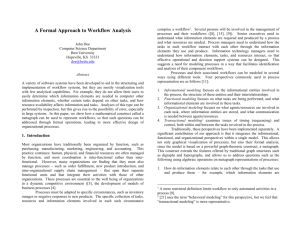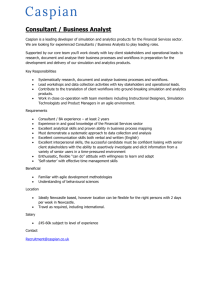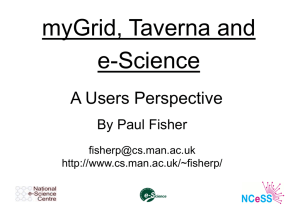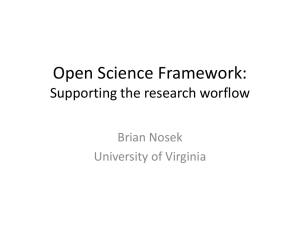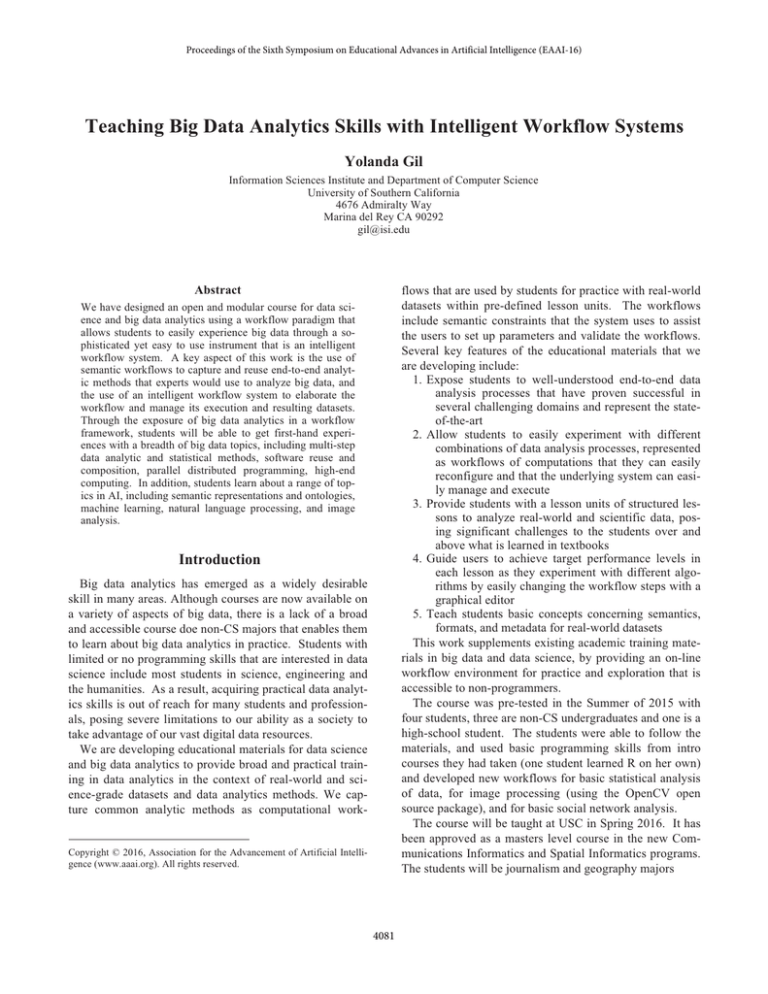
Proceedings of the Sixth Symposium on Educational Advances in Artificial Intelligence (EAAI-16)
Teaching Big Data Analytics Skills with Intelligent Workflow Systems
Yolanda Gil
Information Sciences Institute and Department of Computer Science
University of Southern California
4676 Admiralty Way
Marina del Rey CA 90292
gil@isi.edu
flows that are used by students for practice with real-world
datasets within pre-defined lesson units. The workflows
include semantic constraints that the system uses to assist
the users to set up parameters and validate the workflows.
Several key features of the educational materials that we
are developing include:
1. Expose students to well-understood end-to-end data
analysis processes that have proven successful in
several challenging domains and represent the stateof-the-art
2. Allow students to easily experiment with different
combinations of data analysis processes, represented
as workflows of computations that they can easily
reconfigure and that the underlying system can easily manage and execute
3. Provide students with a lesson units of structured lessons to analyze real-world and scientific data, posing significant challenges to the students over and
above what is learned in textbooks
4. Guide users to achieve target performance levels in
each lesson as they experiment with different algorithms by easily changing the workflow steps with a
graphical editor
5. Teach students basic concepts concerning semantics,
formats, and metadata for real-world datasets
This work supplements existing academic training materials in big data and data science, by providing an on-line
workflow environment for practice and exploration that is
accessible to non-programmers.
The course was pre-tested in the Summer of 2015 with
four students, three are non-CS undergraduates and one is a
high-school student. The students were able to follow the
materials, and used basic programming skills from intro
courses they had taken (one student learned R on her own)
and developed new workflows for basic statistical analysis
of data, for image processing (using the OpenCV open
source package), and for basic social network analysis.
The course will be taught at USC in Spring 2016. It has
been approved as a masters level course in the new Communications Informatics and Spatial Informatics programs.
The students will be journalism and geography majors
Abstract
We have designed an open and modular course for data science and big data analytics using a workflow paradigm that
allows students to easily experience big data through a sophisticated yet easy to use instrument that is an intelligent
workflow system. A key aspect of this work is the use of
semantic workflows to capture and reuse end-to-end analytic methods that experts would use to analyze big data, and
the use of an intelligent workflow system to elaborate the
workflow and manage its execution and resulting datasets.
Through the exposure of big data analytics in a workflow
framework, students will be able to get first-hand experiences with a breadth of big data topics, including multi-step
data analytic and statistical methods, software reuse and
composition, parallel distributed programming, high-end
computing. In addition, students learn about a range of topics in AI, including semantic representations and ontologies,
machine learning, natural language processing, and image
analysis.
Introduction
Big data analytics has emerged as a widely desirable
skill in many areas. Although courses are now available on
a variety of aspects of big data, there is a lack of a broad
and accessible course doe non-CS majors that enables them
to learn about big data analytics in practice. Students with
limited or no programming skills that are interested in data
science include most students in science, engineering and
the humanities. As a result, acquiring practical data analytics skills is out of reach for many students and professionals, posing severe limitations to our ability as a society to
take advantage of our vast digital data resources.
We are developing educational materials for data science
and big data analytics to provide broad and practical training in data analytics in the context of real-world and science-grade datasets and data analytics methods. We capture common analytic methods as computational work-
Copyright © 2016, Association for the Advancement of Artificial Intelligence (www.aaai.org). All rights reserved.
4081
Section
Lesson topics
1
Data
What is data and what is not data; time series data; network data; geospatial data; text data;
labeled and annotated data; big data
2
Data analysis software
Software for data analysis; inputs and outputs of programs; program parameters; programming languages; programs as black boxes
3
Multi-step data analysis
Pre-processing and post-processing data; building workflows by composing programs;
workflows for data analysis; workflow inputs and parameters; running a workflow
4
Data analysis tasks
What is a data analysis task; prediction; classification; clustering; pattern detection; anomaly
detection
5
Data pre-processing
Data cleaning; quality control; data integration; feature selection
6
Data post-processing
Summarization; filtering; visualization
7
Analyzing different types of data
Analyzing time series data; analyzing networked data; analyzing geospatial data; analyzing
text; analyzing images; analyzing video
8
Parallel computing
Cost of computation; parallel processing; multi-core computing; distributed computing;
speedup with parallel computing; dependencies across computations; limits of parallel
speedup; execution failures and recovery; reduction
9
Semantic metadata
What is metadata; basic metadata vs semantic metadata; metadata about data collection;
metadata about data processing; metadata for search and retrieval; metadata standards; domain metadata and ontologies
10
Provenance
What is provenance; provenance concerning data; provenance concerning agents; provenance concerning processes; provenance models; provenance standards
11
Semantic workflows
What is a semantic workflow; validating data analysis methods; automatically generating
metadata; tracking provenance; publishing workflows; finding workflows
12
Visualization
Time series visualizations; geospatial visualizations; multi-dimensional spaces
13
Data stewardship
Data sharing; data identifiers; licenses for data; data citation and attribution
14
Data formats and standards
Data formats; data standards; data services; ontologies; linked open data
Table 1. Major topics in the proposed course on data science for non-programmers.
Although it is always beneficial to learn programming,
not every student is inclined to invest the time and effort to
do so. A course that enables them to learn basic concepts
of data science will be more approachable and still useful.
In the spirit of computational thinking [Wing 2006], our
focus has been to design a curriculum that teaches computing concepts above the level of particular programming
languages and implementations.
Another observation about data science curricula is that
they tend to focus on databases and machine learning, with
little attention to parallel and distributed computing. Although database technologies and machine learning algorithms are important, it is also important to include other
concepts such as scalability through parallelism and distributed computation, as the motivation to learn about data
science is often the pursuit of big data analytics and that
requires understanding how to scale up computation.
Table 1 presents the major sections and topics of our
course for data science. All the topics can be introduced
without requiring programming skills.
The course also has more emphasis on metadata and semantics than are usually included in data science courses.
There is also more emphasis on end-to-end methods for
respectively. The syllabus of the course is available from
[Gil 2015]. The paper presents our approach to teach data
science, gives an overview of the curriculum, and describes
how semantic workflows are used to teach core concepts in
the course complemented by practice with the WINGS
intelligent workflow system.
Data Science for Non-Programmers
Our focus is on students that do not take programming
classes. Our goal is that they learn basic concepts of data
science, so they can understand how to pursue data-driven
research projects in their area and be in a better position to
collaborate with computer scientists in such projects.
Existing courses on data science typically require programming skills. As an example, Coursera’s “Introduction
to Data Science” [Coursera 2015] requires two collegelevel courses in programming. Even when targeted to nonprogrammers, data science curricula focus on teaching
programming. For example, Columbia University’s Journalism School offers a set of courses to introduce students
to data practices [Columbia 2015] that starts out teaching
basic programming skills.
4082
Figure 1: WINGS user interface for composing and validating workflows: (a) a library of components
comp
is available to the user including component classes organized in a hierarchy, (b) a component or a component class can be selected and dragged and
dropped into the canvas, (c) once dropped the component can be connected to express dataflow, (d) the user can add constraints
about the datasets or parameters of the workflow, (e) the user can ask the system to validate the workflow by reasoning about the
semantic constraints, (f) the user can ask the system to expand the constraints of the workflow, even to expand it to add additional
needed parameters and other information. The examples are for text analytics (from [Hauder et al 2011a; Hauder et al 2011b]).
cuted, WINGS ensures that workflows are correctly composed by checking that the data is consistent with the semantic constraints defined for the workflow and its components. Users can track execution progress and view results.
Figure 1 shows a snapshot of the existing WINGS user
interface for composing and validating workflows, in this
case to create applications for text analytics [Hauder et al
2011a; Hauder et al 2011b]. WINGS can represent highlevel workflow templates that have classes of components
as steps (e.g., “TermWeighting”). WINGS workflow templates can also express compactly processing of multiple
objects even before the collections are selected [Gil et al
2009]. WINGS can validate the workflows that are created
by the user by reasoning about the semantic constraints
that have been defined for the workflow, its components,
and all the associated input and output data. WINGS can
execute workflows in several scalable distributed execution
engines [Gil et al 2013]. A high-level introduction to
data analysis, which include data pre-processing, data postprocessing, and visualization.
Learning these concepts must be supplemented with
practice. But how can students with no programming skills
be able to see programs in action? A major component of
the course is the use of an intelligent workflow system that
enables students to practice complex data analysis concepts.
Semantic Workflows
For this work we use the WINGS semantic workflow system [WINGS 2015]. WINGS is an intelligent workflow
system that can assist users, and therefore students, to create valid workflows [Gil et al 2011a] and automate the
elaboration of high-level workflows [Gil et al 2011b]. Users find pre-defined workflows and workflow components
that they can reuse and extend to create their own workflows. As users select and configure workflows to be exe-
4083
Figure 2: Workflows created by text analytics experts: (a) supervised classification of documents, (b) unsupervised clustering of
documents, (c) detection of trending topics in document collections (from [Hauder et al 2011a]).
cessed the difference between which classifier (such as
support vector machines or Naïve Bayes) is applied on the
same feature vector is only 0.5-5%. Second, state-of-the-art
data analytics often involves multi-step methods with sophisticated statistical techniques such as cross-validation
and combinations of algorithms such as ensemble methods.
Such methods are challenging to set up and run and few
users would have requisite experience and infrastructure to
experiment with them. Finally, key data analytic skills can
only be learned by experiencing the performance of different methods with real data, by understanding different data
preparation strategies, and by exploring the relative merits
of different algorithmic choices and their effect in the
overall performance.
Figure 2 illustrates several workflows that capture expert-level methods for text analysis, taken from [Hauder et
al 2011a]. These workflows were used by high-school
students with no programming skills to analyze Web documents [Hauder et al 2011b]. We have had many users of
WINGS who did not have programming skills and were
able to run complex data analytics and understand the
method captured in the workflow.
Students will work with multiple domains and use workflows that capture end-to-end expert-level analytic meth-
WINGS can be found in [Gil et al 2011a], a formal description of the workflow representation language and reasoning algorithms is given in [Gil et al 2011b].
Using Workflows to Teach Big Data Analytics
This section illustrates how the topics in the course are
illustrated using the WINGS intelligent workflow framework.
A major benefit of using WINGS in the course is the ability for students to access expert-grade data analytic methods that are ready to be run with real-world data. Many
courses on different levels of statistics, machine learning
and data mining are offered in most universities and train
students on the relative merits of different algorithms and
statistical techniques. But a course on machine learning or
data mining is not sufficient to prepare students to do data
analytics in practice. First, designing an appropriate endto-end process to prepare and analyze the data plays a
much more influential role than using a novel classifier or
statistical model. For example, in many cases, the prediction accuracy of text classifiers on one dataset can differ 510% depending on how the unstructured texts are converted to feature vectors. In contrast, once the data is prepro-
4084
ods. Many topics in the course require exposing the student to sophisticated methods that work best with different
kinds of data, notably 3, 4, and 7. Other topics are illustrated through the ability of workflows to show how data is
prepared and pre-processed (topics 5 and 6).
Another major benefit of workflows is to illustrate how
programming can be accomplished through software reuse
and composition. More and more every day, many programming tasks involve reuse of libraries or software
packages. Workflows emphasize this paradigm and allow
students to learn a component-based approach to programming, where the components are already pre-defined
and the user’s task is to compose them through data flow
and control flow connectors. These concepts are easy for
non-programmers to understand, and allow them to develop pretty complex applications without formal programming training. In addition, workflows illustrate the concept of heterogeneous software applications, where different components may be implemented in different languages and used together in a workflow. Students can
learn how to create software components from software
packages available in the Web, so they can be empowered
to build workflows for new domains.
The workflows in Figures 1-2 can be used to illustrate
these concepts. These workflows include components
from a variety of software packages and libraries, including generic packages such as MATLAB and R, machine
learning packages such as Weka and Cluto, and text analysis packages such as Mallet. The components can be implemented in a variety of programming languages, including Java, C++, and Python. Workflows allow students with
no programming background to understand and practice
software reuse and composition.
Another key didactic use of workflows is to illustrate
parallel distributed programming concepts. A major challenge in teaching data analytics is the difficulty for students to learn in practical ways about parallel programming. Significant differences among different algorithms
and methods may be only apparent when using data at
larger scales.
Figure 3 shows a workflow for text analytics that contrasts the processing of a collection (left) with the processing of a single document (right). WINGS includes
workflow constructs that manage parallelization starting
from abstract specifications of document and algorithm
collections [Gil et al 2009]. We illustrate those constructs
and their mapping into a Hadoop (MapReduce) infrastructure for workflow execution.
Metadata tracking is another set of topics where workflow systems can be helpful. Students should learn to
manage metadata in analytic processes, as metadata is crucial to provide context to datasets. Metadata includes key
information about: 1) the origins of raw data, such as the
instruments used to collect it or the investigators involved;
Figure 3: A workflow that illustrates parallel processing: it
processes a collection of training data (left) to build a classifier, then it uses it to classify test data (right). The documents
that form the training dataset are preprocessed in parallel,
indicated by the stacks of nodes.
2) the types and relationships across datasets, such as the
temporal extent of each of several datasets; 3) the statistical properties of datasets, such as error rates and other
quality indicators; and 4) the processes applied to derive
new data from raw data sources. Metadata is often poorly
managed and laborious to integrate into analysis steps, and
so it is often lost through analytic processes. Key metadata
is often archived locally by key investigators but not
moved along with the data throughout the analytic process
steps. Metadata for analytic results is tracked manually
and seldom published. Provenance is a kind of metadata
that workflow systems track automatically. A workflow
captures the process that was used to create the workflow
results, which represent the provenance of those results.
Workflow systems can naturally generate provenance
metadata [Kim et al 2007]. WINGS uses the W3C PROV
standard
for
provenance
on
the
Web
(http://www.w3.org/2011/prov/). Many workflow systems
can publish provenance records for workflow executions
[Moreau and Ludaescher 2007]. WINGS is unique in that
it can export these provenance records as well as their associated workflow templates, all as web objects that are
openly accessible and use linked open data principles [Garijo and Gil 2011]. We have developed lesson units devot-
4085
• Image processing: There are workflows where different image processing algorithms are applied to images with different characteristics (black and white
or color, blurry or crisp, outdoors or indoors, faces
or landscapes, etc.) Students can see how different
transformations to an original image can affect the
ability of a segmentation algorithm to detect certain
object boundaries.
• Natural language: The workflows for text processing
include steps for pre-processing text, formulating
features out of words, stemming, and common statistics such as TF-IDF. They also learn to handle
common Web data, such as HTML documents and
tweets. Students can experiment with the workflows using documents of different characteristics
(short or long, news or blogs, etc).
• Network analysis: There are workflows for network
analysis that detect cliques, detect the most influential nodes, and find communication paths.
ed to metadata tracking through a workflow system, which
does it automatically. This allows students to appreciate
the importance of ontologies to describe datasets, and the
role of Semantic Web technologies in providing standard
representations and tools to manage metadata. Students
can learn that process metadata is key for documenting
results, so that they can be interpreted appropriately,
searched based on what processes were used to generate
them, and so that they can be understood and used by others. We have developed lesson units devoted to the importance of metadata and provenance in data analytics,
particularly in a scientific context but also in commercial
contexts where accountability is important.
Finally, workflow systems can help students learn about
the value of visualizations. Visualization courses often
focus on how to process big data at scale to generate visualizations that have illustrative purposes. However, the
utility of visualizations to a user is often neglected. Visualizations need to be put in the context of understanding a
dataset and the results of an analytic method once the data
is processed. In this regard, workflows offer an integrated
view of analytics and visualizations, since they include
both data analytics and visualization steps.
Workflows with data visualizations steps allow students
to understand how data visualizations make a difference in
understanding a problem. In addition, visualizations are
used to show intermediate results of the workflows, which
helps convey the importance of pre-processing and other
data preparation steps in the overall analytic method.
The course was pre-tested in the Summer of 2015 with
four students, three are non-CS undergraduates and one is a
high-school student. We illustrate some of the materials
created by the students doing tasks equivalent to homework assignments.
Figure 4 shows an example of a logic constraint created
by one of the students. It applies to a workflow component
that generates a histogram. It is expressed as an if-then
rule that sets the number of bins depending on the dataset
size ("
), which is a semantic property (metadata) of the input dataset. This constraint represents Sturges’
rule, which sets the number of bins to the logarithm of the
number of data points plus one.
Figure 5 shows an example of a workflow created by a
student using OpenCV components. The student was interested to see if smoothing would affect the quality of the
segmentation algorithm, and how different thresholds
would affect the performance.
An important observation is that the context of data science gives the students a concrete basis to understand the
AI concepts. Because they can experiment with the data,
they can try different AI algorithms and techniques in machine learning, natural language, and image processing.
Because they have to describe the data, they create logic
representations of the data characteristics so the workflows
can reason with them.
Learning AI Topics through Data Science
The students are exposed to several major topics in AI
through the materials in the class. Specifically, they learn
basic knowledge about these key topics:
• Semantic representations and ontologies: The datasets included in the workflow system have types,
which are organized in a class hierarchy and where
each type can have properties. This enables students to learn about how to create ontologies to describe domain information.
• Constraint reasoning: The ontological properties of
the data are used to define metadata of datasets.
The workflow system uses that metadata in logical
rules to assert new metadata of workflow results.
These are logical if-then rules that the students can
define to constrain how the workflow processes the
data.
• Machine learning: The students learn to run classifiers and clustering methods. They see examples of
training data, their features and their labels. They
can try different classifiers and compare their performance. They also learn to run clustering algorithms, and can set up the target number of clusters
to different values to understand how the algorithm
parameter values affect the results.
Related Work
Workflow systems such as Pegasus, Taverna, Kepler,
and others [Deelman et al 2005; Hull et al 2006; Ludäscher
et al 2006] provide sample workflows in their introductory
materials and software downloads, but do not provide
structured lessons. VisTrails has been used to teach a range
of visualization topics [Silva et al 2011].
4086
%""
#
(
$
#
$
#
'"
'$
#
$
#
'""'$
#
$
# )$
#$
!*#
$&
An intelligent workflow system, WINGS, uses those constraints to validate the workflows and assist the students to
set up the analyses properly.
Acknowledgments
We gratefully acknowledge support from the National Science Foundation (NSF) with award ACI-1355475.
References
Columbia
2015].
http://www.journalism.columbia.edu/page/1058-the-ledeprogram-an-introduction-to-data-practices/906
Figure 4: A (simplified) semantic constraint created
by a student to set up a value for an input parameter of
a workflow component.
Coursera 2015. https://www.coursera.org/course/datasci.
Deelman, E., Singh, G., Su, M. H., Blythe, J., Gil, Y., et al.
“Pegasus: a Framework for Mapping Complex Scientific
Workflows onto Distributed Systems.” Scientific Programming Journal, vol. 13, 2005.
R. Dooley, K. Milfeld, C. Guiang, S. Pamidighantam and
G. Allen. “From Proposal to Production: Lessons Learned
Developing the Computational Chemistry Grid Cyberinfrastructure,” 4(2), 2006.
Daniel Garijo and Yolanda Gil. “A New Approach for
Publishing Workflows: Abstractions, Standards, and
Linked Data.” Proceedings of the 6th Workshop on Workflows in Support of Large-Scale Science (WORKS-11),
held in conjunction with SC-11, 2011.
Gil, Yolanda. Syllabus for "Introduction to Computational
Thinking and Data Science". (2015): figshare. Available
from http://dx.doi.org/10.6084/m9.figshare.1614949 Retrieved 00:35, Dec 02, 2015 (GMT)
Gil, Y., Groth, P., Ratnakar, V., and C. Fritz. “Expressive
Reusable Workflow Templates.” Proceedings of the IEEE
e-Science Conference, Oxford, UK, 2009.
Figure 5: A workflow created by a student to explore
how smoothing may affect the quality of segmentation.
Gil, Y.; Ratnakar, V.; Kim, J.; Gonzalez-Calero, P. A.;
Groth, P.; Moody, J.; and Deelman, E. “Wings: Intelligent
Workflow-Based Design of Computational Experiments.”
IEEE Intelligent Systems, 26(1). 2011.
Gil, Y.; Gonzalez-Calero, P. A.; Kim, J.; Moody, J.; and
Ratnakar, V. “A Semantic Framework for Automatic Generation of Computational Workflows Using Distributed
Data and Component Catalogs.” Journal of Experimental
and Theoretical Artificial Intelligence, 23(4), 2011.
Educational tools that use scientific datasets in a few
domains have been investigated [Dooley et al 2006;
Sendlinger et al 2008], but they do not embark in teaching
big data analytics topics.
“Time-Bound Analytic Tasks on Large Datasets through
Dynamic Configuration of Workflows”, Gil, Y., Ratnakar,
V., et al. Proceedings of the 8th Workshop on Workflows
in Support of Large-Scale Science (WORKS-13), held in
conjunction with SC-13, 2013.
Conclusions
We have developed a course for non-programmers to
learn about data science, and in particular concepts of parallel and distributed computing. The course allows the
students to practice by using semantic workflows. The
workflows capture complex multi-step data analysis methods, which include semantic constraints about their use.
Hauder, M., Gil, Y. and Liu, Y. “A Framework for Efficient Text Analytics through Automatic Configuration and
Customization of Scientific Workflows”. Proceedings of
4087
the Seventh IEEE International Conference on e-Science,
Stockholm, Sweden, December 5-8, 2011.
Hauder, M.; Gil, Y.; Sethi, R.; Liu, Y.; and Jo, H. “Making
Data Analysis Expertise Broadly Accessible through
Workflows.” Proceedings of the Sixth Workshop on
Workflows in Support of Large-Scale Science
(WORKS'11), held in conjunction with SC 2011, Seattle,
WA, 2011.
Hull D, Wolstencroft K, Stevens R, Goble C, Pocock M, Li
P, Oinn T. “Taverna: A Tool for Building and Running
Workflows of Services”, Nucleic Acids Research, Vol 34,
2006.
Kim, J.; Deelman, E.; Gil, Y.; Mehta, G.; and Ratnakar, V.
“Provenance Trails in the Wings/Pegasus Workflow System.” Concurrency and Computation: Practice and Experience, Special Issue on the First Provenance Challenge,
20(5). 2008.
Ludäscher, B. et al. “Scientific workflow management and
the Kepler system.” Concurrency and Computation: Practice and Experience. 18, 2006.
Moreau, L. and B. Ludäscher. Concurrency and Computation: Practice and Experience, Special Issue on the First
Provenance Challenge, 20(5). 2008.
Sendlinger, S.C.; DeCoste, D.J.; Dunning, T.H.; Dummitt,
D.A.; Jakobsson, E.; Mattson, D.R.; Wiziecki, E.N.
“Transforming Chemistry Education through Computational Science,” Computing in Science & Engineering,
2008.
C. Silva, E. Anderson, E. Santos, and J. Freire. “Using
VisTrails and Provenance for Teaching Scientific Visualization.” Computer Graphics Forum, 30(1), 2011.
Jeannette Wing. “Computational Thinking”. Communications of the ACM vol. 49, no. 3, March 2006.
WINGS 2015. http://www.wings-workflows.org
4088

